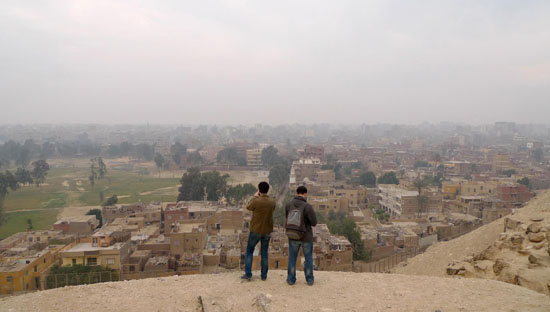 Back to selection
Back to selection
BACK IN TAHRIR

Below Italian filmmaker Saverio Pesapane, who is working on Devotional, a documentary about 2012 presidential elections in Egypt, Russia and the U.S., describes his experiences shooting in Egypt earlier this year. Pesapane has an ongoing Indiegogo campaign for Devotional, which you can contribute to here.
I was in Egypt four times between December and June 2012. Everything started with a request from the curators of the International Architecture Rotterdam Biennale to make a film on the Nile Valley for the 2012 exhibition.
The first time I went, in December 2011, I spent two weeks there, including New Year’s Eve. We were just there to make our first real contact with the people with whom we had been exchanging e-mails in the last months of 2011: some of the revolutionaries who had participated in the protest that led to the fall of Hosni Mubarak.
The first time we arrived in Tahrir Square, the square where all the protests took place and the center of the revolution, the situation was quite calm. The middle of the square held many tents composing a permanent camp created by the protesters, but the rest of the square was being used normally, as it had been before the protest.
It was soon evident that the people in the square were used to being surrounded by film crews. Egypt is a place where It’s easier to ask forgiveness afterwards than permission beforehand, and everyone was taking advantage of this situation, including crews intending to film the protesters. In Tahrir Square, there is a tall building where all the balconies are rented by TV crews paying a few hundred dollars a day to safely film the revolution.
The first time we actually filmed in the square was on New Year’s Eve. Muslim countries don’t celebrate New Years Eve on the 31st of December, but on that night in Tahrir Square there was a celebratory/memorial concert for the victims of the revolution. Some days before, we had carried out an interview on the roof of the Ibn Tulun Mosque, the oldest mosque in the city and one of the most impressive buildings I’ve ever seen. Mazin, a young architect who had taken part in the protest, told us about his personal experience in the revolution, and his interview was so good that I asked him to be our guide in Tahrir Square on New Year’s Eve.
We met Mazin at 10 o’clock at the intersection between Mohamed Mahmoud Street and Tahrir Square. Mohamed Mahmoud was the very epicenter of the fights during the protests, while Tahrir Square was the organizing center. We put a microphone on him and started to film his walk across the crowded square on that strange 31st December in Cairo. He was talking about his days in the square, remembering the police attacks, the resistance the protestors had made, and the attempts to reach the streets where the main institutional buildings are by crossing the Mohamed Mahmoud Street concrete barricades built by the police.
While we were in the square, the crowds started to chant, “Down, down Hosni Mubarak” and the new version of this famous protesters’ chant, with the words “Tantawi” and “the SCAF” taking the place of “Mubarak”.
A month later, on the 4th of February, an immense tragedy (organized by the military, according to the protesters) took place in Port Said, where the police watched without intervening in the massacre of Ahly supporters at the Port Said stadium during a match with the local team. As soon as the news reached Cairo, a protest was immediately organized in Tahrir Square, I called Mazin, who was already downtown, and we agreed to meet in the same place where we had met on New Year’s Eve. The situation, of course, was totally different this time, and the celebration atmosphere of the month before had been replaced by the anger of the supporters of the Ahly team, who came from all over the city to demonstrate their rage. The intersection between Mohamed Mahmoud Street and Tahrir Square was possibly the worst place to be in Cairo in that moment, because it was there that people from Tahrir Square had to cross to reach the Interior Ministry Building, where a massive and violent protest was taking place. The police was reacting with the usual violence, but Mazin wanted to show us a “hot” day from the most intense point of view. Once again, we put the microphone on him, while around us crowds of people were heading in the direction of the Ministry Building and other crowds were going the other way, at times running away, at times their faces covered with blood, at times on stretchers. Ambulances were screaming all around, but we managed to take a short walk-through with Mazin before moving to the safety of the center of Tahrir Square.
The center of Tahrir Square was the eye of the hurricane, and from that odd place I had a different view of the city that night.

